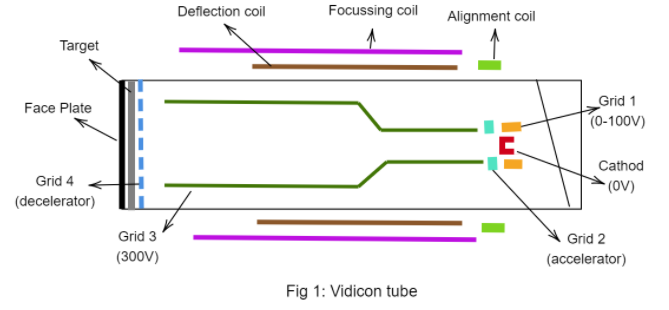
Explain the function of a vidicon camera tube.
Answer
566.1k+ views
Hint:
A vidicon is one of the types of camera tubes whose basis of working is photoconductivity. Let's have the basics of photoconductivity.
Definition of photoconductivity: An increase in the flow of current (conductivity) caused due to exposure to light on its surface.
Vidicon cameras work on the principle of photoconductivity where a beam of rays emerging from a cathode accelerates.
Complete step by step answer:
A Videocon is a kind of camera tube which works on the principles of photoconductivity. It converts optical energy into electrical energy by varying the resistance of the material depending on the illumination of the object to be captured. Its functioning is as described below.

1. Light from the source object passes through a system of lenses and then falls on the faceplate.
2. The target plate is made up of 2 layers- one of tin oxide while the other side has a photoconductive layer. The photo conducting material absorbs light energy and releases free electrons.
3. A positive potential is applied to the signal plate which attracts the free electrons and makes the photo conducting region vacant again. The positive charge on the signal plate is proportional to the number of free electrons.
4. The photoconductive layer has a variable resistance depending on the illumination. It offers high resistivity in the dark whereas it offers low resistivity in bright light.
5. A scanning beam is emitted by the cathode. This is then accelerated and focused on the photoconductive layer by the accelerating grid. This beam is decelerated just before hitting the material to avoid secondary emissions.
6. Electrons from the scanning beam get deposited on the target plate to neutralize the vacancy of free electrons. This produces an electric current.
Note:
Remember the functionality of Grids in the arrangement:
Grid 1: It is the place where the source of electrons is located (called electron gun)
Grid 2: It accelerates electron toward Grid 3 (called as accelerator Grid)
Grid 3: It focusses the accelerated electrons onto photoconductive plates.
Don’t forget to remember the principle of photoconductivity.
A vidicon is one of the types of camera tubes whose basis of working is photoconductivity. Let's have the basics of photoconductivity.
Definition of photoconductivity: An increase in the flow of current (conductivity) caused due to exposure to light on its surface.
Vidicon cameras work on the principle of photoconductivity where a beam of rays emerging from a cathode accelerates.
Complete step by step answer:
A Videocon is a kind of camera tube which works on the principles of photoconductivity. It converts optical energy into electrical energy by varying the resistance of the material depending on the illumination of the object to be captured. Its functioning is as described below.

1. Light from the source object passes through a system of lenses and then falls on the faceplate.
2. The target plate is made up of 2 layers- one of tin oxide while the other side has a photoconductive layer. The photo conducting material absorbs light energy and releases free electrons.
3. A positive potential is applied to the signal plate which attracts the free electrons and makes the photo conducting region vacant again. The positive charge on the signal plate is proportional to the number of free electrons.
4. The photoconductive layer has a variable resistance depending on the illumination. It offers high resistivity in the dark whereas it offers low resistivity in bright light.
5. A scanning beam is emitted by the cathode. This is then accelerated and focused on the photoconductive layer by the accelerating grid. This beam is decelerated just before hitting the material to avoid secondary emissions.
6. Electrons from the scanning beam get deposited on the target plate to neutralize the vacancy of free electrons. This produces an electric current.
Note:
Remember the functionality of Grids in the arrangement:
Grid 1: It is the place where the source of electrons is located (called electron gun)
Grid 2: It accelerates electron toward Grid 3 (called as accelerator Grid)
Grid 3: It focusses the accelerated electrons onto photoconductive plates.
Don’t forget to remember the principle of photoconductivity.
Recently Updated Pages
Master Class 12 Economics: Engaging Questions & Answers for Success

Master Class 12 Maths: Engaging Questions & Answers for Success

Master Class 12 Biology: Engaging Questions & Answers for Success

Master Class 12 Physics: Engaging Questions & Answers for Success

Basicity of sulphurous acid and sulphuric acid are

Master Class 12 Business Studies: Engaging Questions & Answers for Success

Trending doubts
What are the major means of transport Explain each class 12 social science CBSE

Which are the Top 10 Largest Countries of the World?

Draw a labelled sketch of the human eye class 12 physics CBSE

How much time does it take to bleed after eating p class 12 biology CBSE

Explain sex determination in humans with line diag class 12 biology CBSE

Differentiate between homogeneous and heterogeneous class 12 chemistry CBSE




